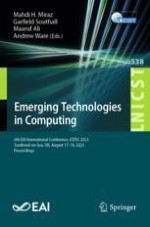2024 | Book
Emerging Technologies in Computing
6th EAI International Conference, iCETiC 2023, Southend-on-Sea, UK, August 17-18, 2023, Proceedings
Editors: Mahdi H. Miraz, Garfield Southall, Maaruf Ali, Andrew Ware
Publisher: Springer Nature Switzerland
Book Series : Lecture Notes of the Institute for Computer Sciences, Social Informatics and Telecommunications Engineering
